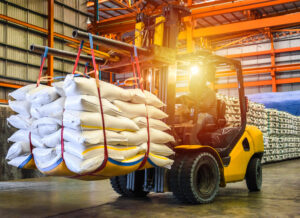
The UK is truly an importing superpower, welcoming over £893 billion worth of goods through its ports every year. But even at this vast scale, all shipments need to pass through the formidable checkpoint of customs clearance, where diligent officers verify documents and inspect goods before releasing them into the country.
A delay in getting customs approval can bring business screeching to a halt, stalling inventory and cash flow. But when it comes to the clearance process, knowledge is power.
This guide will break down everything top-to-bottom, equipping importers with helpful strategies for keeping things moving along without issue. The goal is to give you the tools to steer clear of potential snags and set your shipments sailing smoothly onward.
What Is Customs Clearance and Why Does It Matter?
The customs clearance process involves inspecting imported goods and reviewing paperwork to confirm items comply with regulations for legal entry. In the UK, it serves two primary purposes:
Assessing and collecting applicable duties and taxes to be paid based on the type and value of goods
Enforcing import restrictions and safety standards.
When clearance gets held up, it creates a domino effect of headaches for importers. Without the green light from customs, goods grind to a halt in storage, racking up fees while creating shortages and cash flow issues on your end. Fail to resolve any problems and customs returns items overseas or destroys them – massive wasted costs that most businesses understandably want to avoid.
Key Requirements for Customs Clearance
All imports require clearance, so importers should deeply understand the process and prepare extensively to avoid painful financial and operational impacts to their business. With this in mind, here are the key requirements:
Obtain an EORI Number
An Economic Operator Registration and Identification (EORI) number is a unique ID code for businesses moving goods between the UK and other countries. If you move goods to or from Great Britain you must get an EORI number that starts with GB. Applying for an EORI number is free and essential for customs clearance. Without one, importers can’t complete declarations or have goods released.
Classify and Value Goods
Successfully traversing customs means dotting your Is ad crossing your Ts – that includes correctly classifying imports with the proper trade tariff codes. Those codes determine duty and VAT rates. Tempting as it may be, undervaluing goods to slash taxes can spur penalties down the road. Instead, aim for ultra precise product categories, declared values, and origin details to keep the customs voyage smooth sailing.
Documentation and Certification Requirements
Importing means reams of paperwork for customs to pick apart: commercial invoices, packing lists, Terms of Trade (e.g. DAP), and for regulated goods, certificates vouching for safety and compliance. Omissions or inaccuracies in documents can cause shipment delays, extra inspections, and general headaches. Carefully compile a complete dossier for each shipment to breeze through reviews.
The Customs Clearance Step-By-Step Process
Imported goods must pass through a series of key clearance steps before finally reaching their destination. The stages include:
Arrival At Port – Shipments reach their named UK port of entry (e.g. Felixstowe, Southampton) and the carrier files paperwork announcing the goods’ arrival. Customs reviews documentation for any issues.
Document Checks – Customs thoroughly examines critical import documents like invoices and certificates of origin, assessing if goods correctly align to the declared classifications and values.
Physical Inspection – Officers may opt to physically inspect a portion of shipments to verify product details match provided documents and comply with regulations. Inspections ensure no restricted, hazardous, or counterfeit items enter.
Duty And Tax Payment – Businesses receive a formal bill of the total duties, tariffs, fees, and VAT owed based on what was imported. Payment must be made promptly before goods can exit.
Release Of Goods – With taxes settled and no issues identified in earlier verification steps, customs can finally approve the shipment for release. Goods may now exit the port and continue to their final destination.
Tips for Streamlining Customs Clearance
Now, let’s take a look at some top tips to help ensure your good move through customs without a hitch:
Have a Methodical Documentation Process
Carefully prepare a centralised folder with all key import papers – product classifications, certificates of origin/analysis, invoices, packing lists, etc. Double check data is consistent across forms. Disorganised records filled with errors are a red flag that lead to shipment delays or fines.
Bring in the Experts (Optional but Helpful)
Customs brokers and freight forwarders are international trade pros that can guide businesses through import regulations and paperwork. They interface directly with customs authorities, sparing importers major headaches. Freight forwarders also ease logistics like booking cargo, documentation, clearance, and final delivery. With experts owning the import process, companies can focus on selling.
Enhance Supply Chain Visibility
Unexpected events like weather, labour strikes, or port congestion can quickly escalate into customs problems. Proactively enroll in tracking tools sending SMS, email or app updates on shipment status and location throughout the international journey – from departure at origin to arrival at destination port. Real-time visibility flags issues early.
Research Applicable Import Regulations
Vet product ingredients, origins, safety reports, etc. to confirm needed clearances or restrictions. For example, certain food items face bans from countries with disease outbreaks, while chemicals and electronics require composition analysis certificates. Missing permits means cargo doesn’t get released.
Final Word
Getting imports smoothly through customs is mission critical, but the maze of documents, duties, and restrictions can certainly seem daunting.
The path forward? Methodically check all the right boxes – properly classify goods, complete paperwork, work with responsive brokers, enable real-time tracking. Moving items internationally means playing by strict rules, so importers have to put in the diligence to follow best practices and build strategic capabilities to keep cargo flowing freely across borders.
When treated with care and expertise, customs become an ally rather than an adversary. And smart preparation is ultimately the key that unlocks success.
Read more:
Demystifying the Customs Clearance Process (Imports): A Guide for UK SMEs




